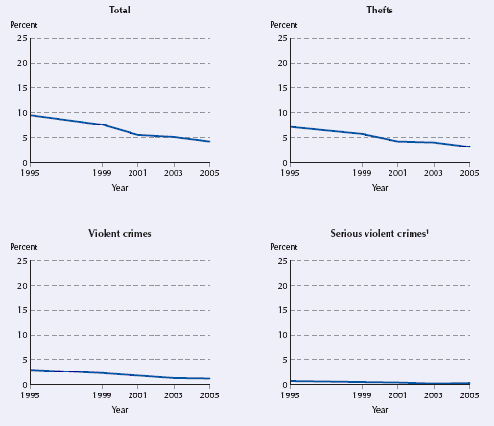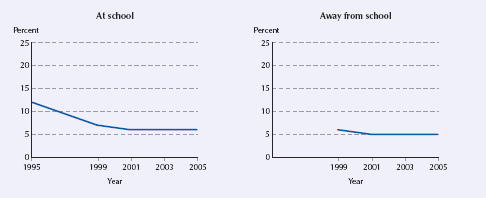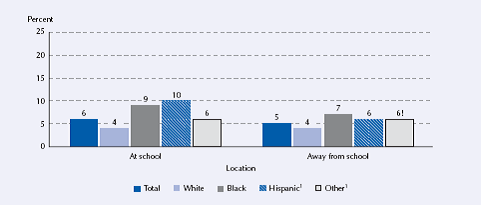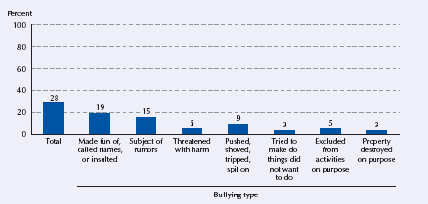Prevalence of Victimization at School
In 2005, some 4 percent of students ages 12–18 reported being victimized at school during the previous 6 months. About 3 percent reported theft, 1 percent reported violent victimization and less than half of a percent of students reported serious violent victimization. Overall, the percentage of students ages 12–18 who were victimized at school during the previous 6 months decreased between 1995 and 2005 from 10 to 4 percent, and the percentage of students reporting victimization for all categories decreased between 1995 and 2005 overall (figure1).
Figure 1. Percentage of students ages 12–18 who reported criminal victimization at school during the previous 6 months, by type of victimization: Various years, 1995–2005

1 Serious violent crimes are also included in violent crimes.
NOTE: Theft includes purse snatching, pick pocketing, all burglaries, attempted forcible entry, and all attempted and completed thefts except motor vehicle thefts. Theft does not include robbery in which threat or use of force is involved. Serious violent crimes include rape, sexual assault, robbery, and aggravated assault. Violent crimes include serious violent crimes and simple assault. Total crimes include violent crimes and theft.
SOURCE: Figure 3.1 in Dinkes, R., Cataldi, E.F., and Lin-Kelly, W. (2007).
Indicators of School Crime and Safety: 2007 (
NCES 2008-021/NCJ 219553). National Center for Education Statistics, Institute of Education Sciences, U.S. Department of Education, and Bureau of Justice Statistics, Office of Justice Programs, U.S. Department of Justice. Washington, DC.
Student Perceptions and Bullying
School violence can make students fearful and affect their readiness and ability to learn, and concerns about vulnerability to attacks detract from a positive school environment.1 In the School Crime Supplement to the National Crime Victimization Survey, students ages 12–18 were asked how often they had been afraid of attack “at school or on the way to and from school” and “away from school” during the previous 6 months. Consistent with findings from 1999 and 2001, students in 2005 were more likely to report being afraid of an attack at school than away from school. In 2005, approximately 6 percent of students ages 12–18 reported that they were afraid of attack or harm at school, and 5 percent reported that they were afraid of attack or harm away from school (figure2).
Figure 2. Percentage of students ages 12–18 who reported being afraid of attack or harm during the previous 6 months, by location: Various years, 1995–2005

NOTE: “At school” includes the school building, on school property, on a school bus, and, from 2001 onward, going to and from school. For the 2001 survey, the wording was changed from “attack or harm” to “attack or threat of attack.” Includes students who reported that they sometimes or most of the time feared being victimized in this way. Fear of attack away from school was not collected in 1995. In 2005, the unit response rate for this survey did not meet NCES statistical standards; therefore, interpret the data with caution. For more information please see appendix A in
NCES 2008-021. Population sizes for students ages 12–18 are 23,325,000 in 1995; 24,614,000 in 1999; 24,315,000 in 2001; 25,684,000 in 2003; and 25,811,000 in 2005.
SOURCE: Figure 17.1 in Dinkes, R., Cataldi, E.F., and Lin-Kelly, W. (2007).
Indicators of School Crime and Safety: 2007 (
NCES 2008-021/NCJ 219553). National Center for Education Statistics, Institute of Education Sciences, U.S. Department of Education, and Bureau of Justice Statistics, Office of Justice Programs, U.S. Department of Justice. Washington, DC.
Black and Hispanic students were more likely than White students to fear for their safety regardless of location in 2005. Nine percent of Black students and 10 percent of Hispanic students reported that they were afraid of being attacked at school (including on the way to and from school), compared with 4 percent of White students (figure 3).
Figure 3. Percentage of students ages 12–18 who reported being afraid of attack or harm during the previous 6 months, by location and race/ethnicity: 2005

! Interpret data with caution.
1 Other includes American Indian, Alaska Native, Asian or Pacific Islander, and more than one race. For this report, non-Hispanic students who identified themselves as more than one race were included in the Other category. Respondents who identified themselves as being of Hispanic origin are classified as Hispanic, regardless of their race.
NOTE: “At school” includes the school building, on school property, on a school bus, or going to and from school. Includes students who reported that they sometimes or most of the time feared being victimized in this way. In 2005, the unit response rate for this survey did not meet NCES statistical standards; therefore, interpret the data with caution. For more information, please see appendix A in
NCES 2008-021. Population size for students ages 12–18 is 25,811,000 in 2005.
SOURCE: Figure 17.2 in Dinkes, R., Cataldi, E.F., and Lin-Kelly, W. (2007).
Indicators of School Crime and Safety: 2007 (
NCES 2008-021/NCJ 219553). National Center for Education Statistics, Institute of Education Sciences, U.S. Department of Education, and Bureau of Justice Statistics, Office of Justice Programs, U.S. Department of Justice. Washington, DC.
Both bullying and being bullied at school are associated with key violence-related behaviors, including carrying weapons, fighting, and sustaining injuries from fighting.2 In 2005, about 28 percent of students reported having been bullied at school during the last 6 months (figure 4). Nineteen percent of students said that they had experienced bullying that consisted of being made fun of; 15 percent reported being the subject of rumors; and 9 percent said that they were pushed, shoved, tripped, or spit on. Of those students who had been bullied, 79 percent said that they were bullied inside the school, and 28 percent said that they were bullied outside on school grounds.
Figure 4. Percentage of students ages 12–18 who reported selected bullying problems at school during the previous 6 months, by type of bullying: 2005
NOTE: “At school” includes the school building, on school property, on a school bus, or going to and from school. Types of bullying do not sum to total because students could have experienced more than one type of bullying. In 2005, the unit response rate for this survey did not meet NCES statistical standards; therefore, interpret the data with caution. For more information, please see appendix A in
NCES 2008-021. Population size for students ages 12–18 is 25,811,000 in 2005.
SOURCE: Figure 11.1 in Dinkes, R., Cataldi, E.F., and Lin-Kelly, W. (2007).
Indicators of School Crime and Safety: 2007 (
NCES 2008-021/NCJ 219553). National Center for Education Statistics, Institute of Education Sciences, U.S. Department of Education, and Bureau of Justice Statistics, Office of Justice Programs, U.S. Department of Justice. Washington, DC.
1 Scheckner, S., Rollins, S.A., Kaiser-Ulrey, C., and Wagner, R. (2002). School Violence in Children and Adolescents: A Meta-Analysis of Effectiveness. Journal of School Violence, 1: 5–34.
2 Nansel, T.R., Overpeck, M.D., Haynie, D.L., Ruan, W.J., and Scheidt, P.C. (2003). Relationships Between Bullying and Violence Among U.S. Youth. Archives of Pediatric and Adolescent Medicine, 157(4): 348–353.
Top





